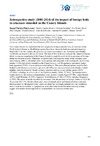Please use this identifier to cite or link to this item:
https://accedacris.ulpgc.es/jspui/handle/10553/71336
| Title: | Retrospective study (2000-2014) of the impact of foreign body in cetaceans stranded on the Canary Islands | Authors: | Puig Lozano, Raquel Patricia García Álvarez, Natalia Sacchini , Simona Sierra Pulpillo, Eva María Diaz Delgado, Josue Zucca, Daniele De La Fuente Marquez, Jesus Fernández Rodríguez, Antonio Jesús Arbelo Hernández, Manuel Antonio |
UNESCO Clasification: | 310907 Patología 240119 Zoología marina |
Issue Date: | 2016 | Journal: | I International congress of microplastics | Conference: | 30th Conference of the European Cetacean Society, Funchal, Madeira, 2016 | Abstract: | The Canary Islands are considered the area of greatest richness and diversity of cetaceans in the North Atlantic Ocean, as 30 different species have been observed, both resident and migratory. Since half of the last century, the pollution of marine environment has increased exponentially worldwide due in part to the use of plastic. The aim of this study is to estimate the impact of marine debris in cetacean population of the Canary Islands through the analysis of the presence of foreign bodies in stranded animals. Therefore, we performed a retrospective study of the necropsy cases since January 2000 to December 2014. In this period, 464 cetaceans were necropsied, out of a total number of 646 individuals stranded on the Canary Islands, and 36 specimens presented foreign body ingestion (7.76% of stranded necropsied animals). The most affected species were Cuvier's beaked whale (Ziphius cavirostris), sperm whale (Physeter macrocephalus) and Atlantic spotted dolphin (Stenella frontalis). Nearly all these cetaceans belong to deep-diving species 20/36 (55.56%), including 10 individuals of the Ziphiidae family (10/36; 27.78%). The foreign bodies found, mostly in the stomach compartments, were: plastics (mainly bags) (77.78%), ropes/threads (25%), metal filaments (8.33%), fragments of cloth/pieces of fabric (5.56%), and glass fragments (2.78%). The cause of death was directly associated with the presence of foreign bodies in 13 of the 36 animals (36.11%). Besides these cases, several animals presented intestinal obstruction and bleeding ulcers in the digestive tract were also observed. Although currently it is not possible to make a statistical inference to a population level, these data should be taken seriously as they suggest that marine debris ingestion is a real problem for cetaceans in this area. | URI: | https://accedacris.ulpgc.es/handle/10553/71336 | Source: | 30th Annual Conference of the European Cetacean Society. Madeira, Portugal, 14-16 March 2016 / Luís Freitas; Cláudia Ribeiro (ed.), p. 244 |
| Appears in Collections: | Póster de congreso |
Page view(s)
214
checked on May 31, 2025
Download(s)
54
checked on May 31, 2025
Google ScholarTM
Check
Share
Export metadata
Items in accedaCRIS are protected by copyright, with all rights reserved, unless otherwise indicated.
